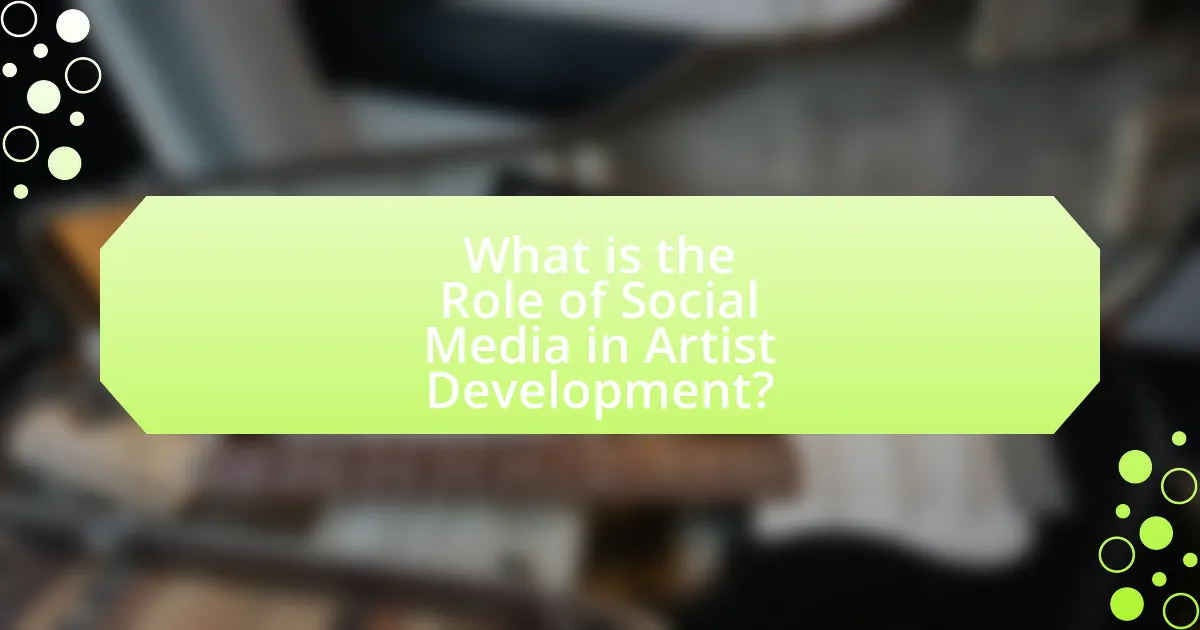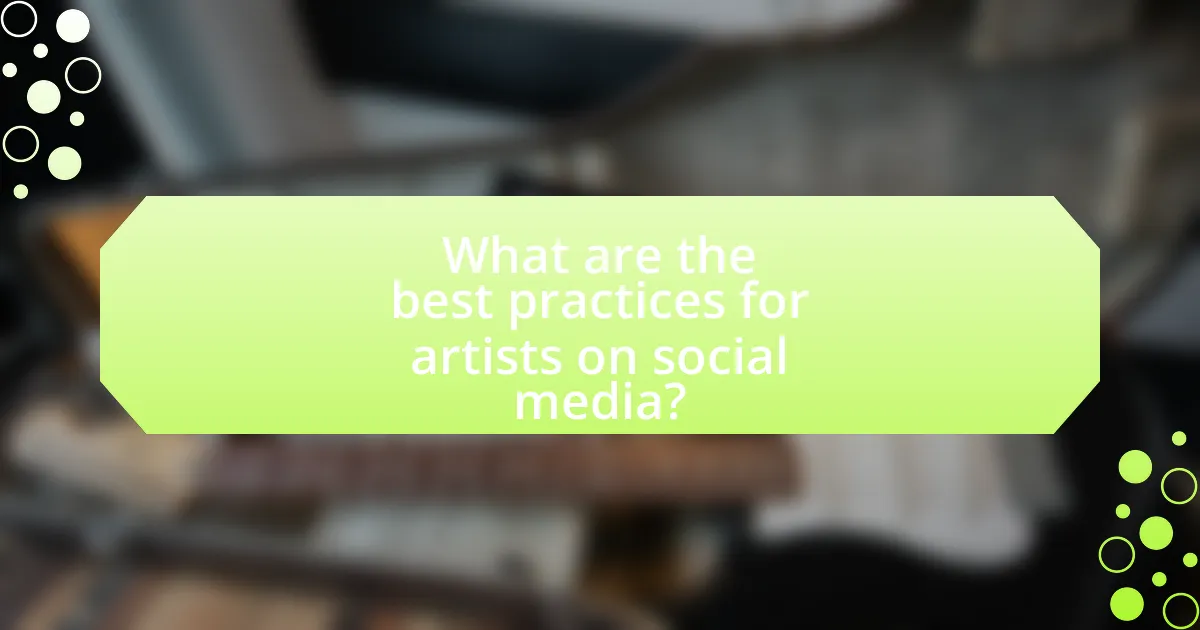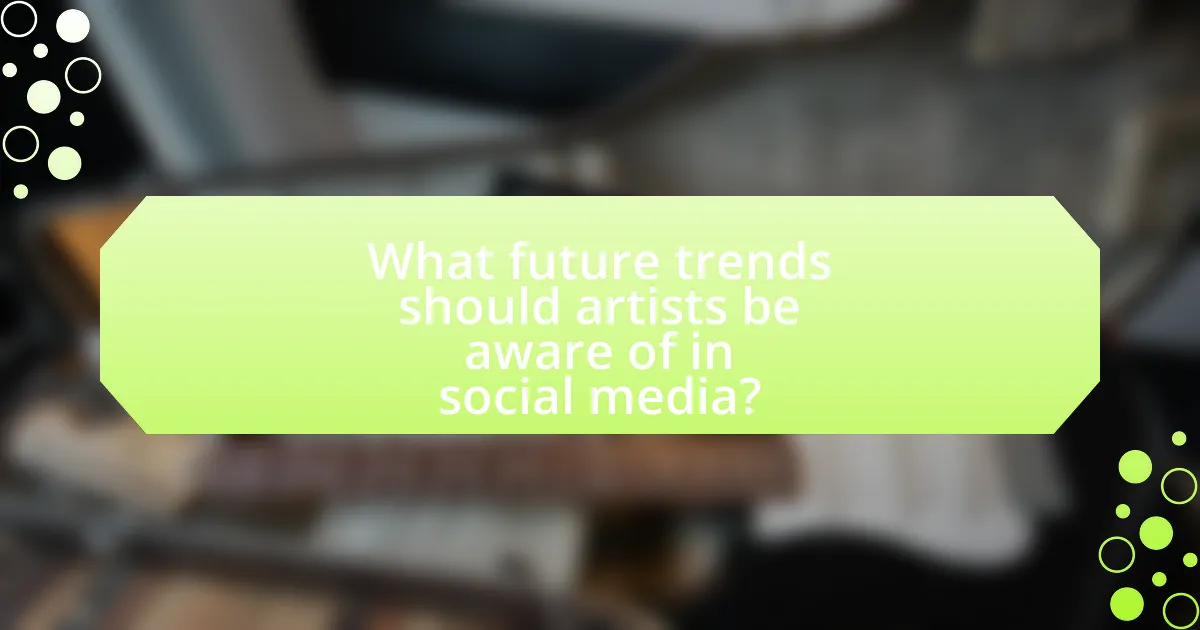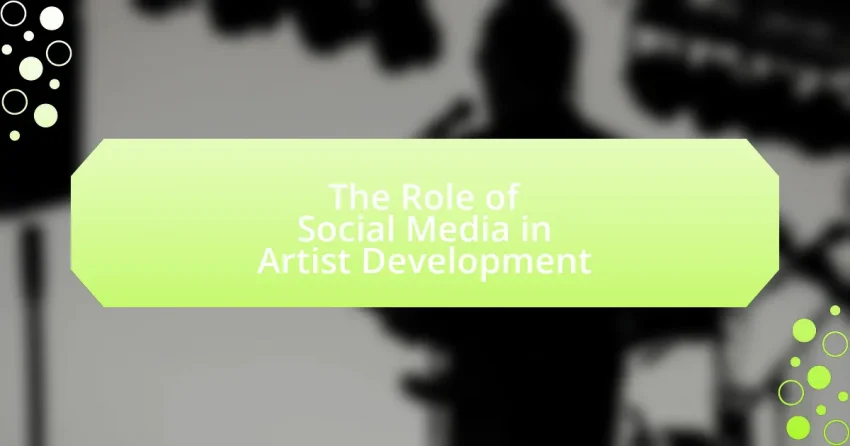The article examines the significant role of social media in artist development, highlighting its importance for exposure, audience engagement, and brand building. It discusses how platforms like Instagram, TikTok, YouTube, and Spotify have transformed the landscape by enabling direct interaction between artists and their audiences, allowing for real-time feedback and community building. The article also addresses the challenges artists face on social media, such as content oversaturation and negative feedback, while providing strategies for effective engagement and content creation. Additionally, it explores emerging trends and tools that can assist artists in optimizing their social media presence for career growth.

What is the Role of Social Media in Artist Development?
Social media plays a crucial role in artist development by providing platforms for exposure, audience engagement, and brand building. Artists utilize social media to showcase their work, connect with fans, and create a personal brand, which is essential in a competitive industry. For instance, a study by the Pew Research Center found that 72% of adults use social media, making it a vital tool for artists to reach a broad audience. Additionally, social media allows for real-time feedback and interaction, enabling artists to adapt their strategies based on audience preferences. This dynamic interaction fosters a community around the artist, enhancing loyalty and support, which are critical for long-term success in their careers.
How has social media transformed the landscape of artist development?
Social media has fundamentally transformed artist development by enabling direct engagement between artists and their audiences. This shift allows artists to build their brand, share their work, and receive immediate feedback without traditional gatekeepers like record labels. For instance, platforms like Instagram and TikTok have become essential tools for artists to showcase their talent, with TikTok’s algorithm allowing songs to go viral, leading to significant increases in streaming numbers. According to a report by the Recording Industry Association of America, 2021 saw a 13% increase in music streaming revenue, partly attributed to social media-driven trends. This direct connection fosters a more authentic relationship with fans, which is crucial for long-term success in the music industry.
What are the key platforms influencing artist development?
Key platforms influencing artist development include Instagram, TikTok, YouTube, and Spotify. Instagram serves as a visual showcase for artists, allowing them to connect with fans and promote their work through engaging content. TikTok has rapidly become a powerful tool for viral marketing, enabling artists to reach new audiences through short, creative videos. YouTube remains a critical platform for music discovery and fan engagement, with its vast user base and monetization options for creators. Spotify, as a leading streaming service, plays a significant role in artist exposure and playlist placements, which can significantly boost an artist’s career. These platforms collectively shape how artists develop their brand, engage with audiences, and distribute their music.
How do these platforms differ in their impact on artists?
Different social media platforms impact artists in distinct ways based on their audience engagement, content format, and algorithmic visibility. For instance, Instagram emphasizes visual content, allowing artists to showcase their work through images and videos, which can lead to higher engagement rates and immediate feedback from followers. In contrast, Twitter focuses on text-based communication, enabling artists to share thoughts, updates, and engage in conversations, which can foster community and networking opportunities. Additionally, platforms like TikTok leverage short-form video content, often going viral, which can significantly increase an artist’s exposure and reach a broader audience quickly. These differences illustrate how the unique characteristics of each platform shape the way artists connect with their audience and promote their work.
Why is social media essential for emerging artists?
Social media is essential for emerging artists because it provides a platform for visibility and engagement with a global audience. This accessibility allows artists to showcase their work, connect with fans, and build a personal brand without the need for traditional gatekeepers like galleries or record labels. According to a 2021 survey by the National Endowment for the Arts, 70% of artists reported that social media significantly contributed to their ability to reach new audiences and promote their work. Additionally, platforms like Instagram and TikTok have algorithms that favor creative content, enabling artists to gain traction quickly and organically.
What opportunities does social media provide for exposure?
Social media provides artists with extensive opportunities for exposure by enabling them to reach a global audience instantly. Platforms like Instagram, Facebook, and TikTok allow artists to showcase their work, engage with fans, and build a personal brand without the need for traditional gatekeepers such as record labels or galleries. For instance, a study by the Pew Research Center indicates that 72% of the public uses social media, which significantly increases the potential audience for artists. Additionally, social media algorithms can amplify content, allowing posts to go viral and reach millions, further enhancing visibility and engagement.
How does social media facilitate audience engagement?
Social media facilitates audience engagement by providing platforms for direct interaction between artists and their fans. These platforms enable artists to share content, receive immediate feedback, and foster community through comments, likes, and shares. For instance, a study by the Pew Research Center found that 69% of adults in the U.S. use social media, highlighting its widespread reach and potential for engagement. Additionally, social media allows for real-time communication, which can enhance the connection between artists and their audience, making fans feel more involved and valued.
What challenges do artists face when using social media?
Artists face several challenges when using social media, including oversaturation of content, algorithm changes, and the pressure to maintain engagement. The oversaturation of content makes it difficult for individual artists to stand out, as millions of posts compete for attention daily. Additionally, frequent algorithm changes on platforms like Instagram and Facebook can limit the visibility of an artist’s work, impacting their reach and engagement rates. Furthermore, the pressure to consistently produce content and interact with followers can lead to burnout, detracting from the creative process. These challenges highlight the complexities artists navigate in leveraging social media for their development and visibility.
How can negative feedback on social media affect an artist’s career?
Negative feedback on social media can significantly harm an artist’s career by damaging their reputation and reducing audience engagement. When artists receive negative comments or reviews, it can lead to a decline in their perceived credibility and popularity, which may result in fewer opportunities for collaborations, performances, or sales. Research indicates that 70% of consumers are influenced by online reviews, and negative feedback can deter potential fans or clients from supporting the artist. Additionally, persistent negative feedback can affect the artist’s mental health, leading to decreased creativity and productivity, further hindering their career growth.
What are the risks of oversharing on social media?
Oversharing on social media poses significant risks, including privacy invasion, identity theft, and reputational damage. When individuals disclose excessive personal information, they become vulnerable to cybercriminals who can exploit this data for malicious purposes, such as stealing identities or committing fraud. According to a study by the Pew Research Center, 64% of Americans have experienced some form of online harassment, which can be exacerbated by oversharing. Additionally, oversharing can lead to negative perceptions by peers and potential employers, as 70% of employers reportedly use social media to screen candidates, making it crucial to maintain a professional online presence.
How can artists effectively utilize social media for their development?
Artists can effectively utilize social media for their development by creating engaging content, building a personal brand, and connecting with their audience. Engaging content, such as behind-the-scenes videos, live performances, and interactive posts, helps artists showcase their work and personality, fostering a deeper connection with followers. Building a personal brand involves consistent messaging and visual identity across platforms, which can enhance recognition and loyalty among fans. Connecting with the audience through comments, direct messages, and collaborations can lead to increased visibility and opportunities, as social media algorithms often favor content that generates interaction. According to a study by the Pew Research Center, 72% of adults use social media, indicating a vast potential audience for artists to reach and engage with.
What strategies can artists implement to grow their following?
Artists can grow their following by consistently engaging with their audience on social media platforms. Regularly posting high-quality content, such as behind-the-scenes footage, live performances, and personal stories, fosters a connection with fans. Additionally, collaborating with other artists and influencers can expand their reach, as seen in studies showing that cross-promotion can increase visibility by up to 30%. Utilizing targeted hashtags and participating in trending challenges also enhances discoverability, leading to a broader audience. Engaging with followers through comments and direct messages builds community, which is crucial for retention and growth.
How can artists create engaging content that resonates with their audience?
Artists can create engaging content that resonates with their audience by understanding their audience’s preferences and utilizing storytelling techniques. By analyzing audience demographics and engagement metrics, artists can tailor their content to reflect the interests and values of their followers. For instance, a study by the Pew Research Center indicates that 72% of adults use social media, highlighting its importance as a platform for artists to connect with their audience. Additionally, incorporating personal narratives and authentic experiences into their content fosters a deeper emotional connection, as research shows that storytelling can increase audience engagement by up to 300%. Thus, by leveraging audience insights and storytelling, artists can effectively create content that resonates.

What are the best practices for artists on social media?
The best practices for artists on social media include consistent posting, engaging with followers, utilizing analytics, and showcasing authentic content. Consistent posting helps maintain visibility and keeps the audience engaged; studies show that brands that post regularly see a 50% increase in engagement. Engaging with followers through comments and direct messages fosters community and loyalty, which is crucial for artist development. Utilizing analytics tools allows artists to track performance and adjust strategies based on audience preferences, leading to more effective content. Lastly, showcasing authentic content resonates more with audiences, as 86% of consumers prefer authenticity in brands, which can significantly enhance an artist’s reputation and reach.
How can artists maintain authenticity while promoting themselves?
Artists can maintain authenticity while promoting themselves by staying true to their unique voice and values in their messaging and content. This involves sharing genuine experiences, thoughts, and creative processes that reflect their individuality rather than conforming to trends or external expectations. Research indicates that audiences are more likely to engage with authentic content, as highlighted in a study by the University of Southern California, which found that authenticity significantly influences audience trust and loyalty. By prioritizing their artistic integrity and connecting with their audience on a personal level, artists can effectively promote themselves without compromising their authenticity.
What role does storytelling play in an artist’s social media presence?
Storytelling is crucial in an artist’s social media presence as it fosters emotional connections with the audience. By sharing personal narratives, experiences, and creative processes, artists can engage followers on a deeper level, enhancing relatability and authenticity. Research indicates that posts incorporating storytelling elements receive 300% more engagement than those that do not, highlighting the effectiveness of this approach in building a loyal fan base. Furthermore, storytelling allows artists to differentiate themselves in a saturated market, making their brand memorable and impactful.
How can artists balance personal and professional content?
Artists can balance personal and professional content by establishing clear boundaries and creating a content strategy that delineates the two. By defining specific themes or topics for personal posts, such as hobbies or daily life, and contrasting them with professional updates like new projects or exhibitions, artists can maintain a cohesive online presence. Research indicates that 70% of consumers prefer to connect with brands that share personal stories, suggesting that a blend of personal and professional content can enhance engagement while still keeping the artist’s brand intact.
What tools and resources can assist artists in managing their social media?
Artists can utilize various tools and resources to effectively manage their social media, including scheduling platforms, analytics tools, and content creation resources. Scheduling platforms like Hootsuite and Buffer allow artists to plan and automate their posts across multiple social media channels, saving time and ensuring consistent engagement. Analytics tools such as Sprout Social and Google Analytics provide insights into audience behavior and engagement metrics, enabling artists to refine their strategies based on data-driven decisions. Additionally, content creation resources like Canva and Adobe Spark assist artists in designing visually appealing graphics and promotional materials tailored for social media, enhancing their online presence. These tools collectively empower artists to streamline their social media management, optimize their outreach, and foster audience connections.
Which analytics tools are most beneficial for artists?
The most beneficial analytics tools for artists include Google Analytics, Spotify for Artists, and Instagram Insights. Google Analytics provides detailed insights into website traffic and user behavior, allowing artists to understand their audience better. Spotify for Artists offers data on streaming performance, listener demographics, and engagement metrics, which helps artists tailor their music and marketing strategies. Instagram Insights enables artists to track engagement rates, follower growth, and post performance, facilitating effective social media strategies. These tools collectively empower artists to make data-driven decisions that enhance their visibility and growth in the digital landscape.
How can scheduling tools improve an artist’s social media strategy?
Scheduling tools can significantly enhance an artist’s social media strategy by enabling consistent and timely content posting. These tools allow artists to plan and automate their posts across various platforms, ensuring that their audience receives regular updates without the need for constant manual effort. For instance, research indicates that brands that post consistently see a 67% increase in engagement compared to those that do not. By utilizing scheduling tools, artists can analyze optimal posting times based on audience activity, thereby maximizing reach and interaction. Additionally, these tools often provide analytics features that help artists track performance metrics, allowing for data-driven adjustments to their strategy.

What future trends should artists be aware of in social media?
Artists should be aware of the increasing importance of short-form video content on social media platforms. As platforms like TikTok and Instagram prioritize video, artists can engage audiences more effectively through creative, concise storytelling. According to a report by HubSpot, 54% of consumers prefer video content from brands, indicating a shift in audience preference that artists can leverage to enhance visibility and connection with fans. Additionally, the rise of augmented reality (AR) features in social media apps allows artists to create immersive experiences, further engaging their audience and differentiating their work in a crowded market.
How is the role of social media evolving in the music industry?
The role of social media in the music industry is evolving into a primary platform for artist promotion and fan engagement. Artists increasingly utilize platforms like Instagram, TikTok, and Twitter to share their music, connect with fans, and build their brand, which has become essential for success in a competitive market. For instance, TikTok has been instrumental in launching viral music trends, with songs like “Old Town Road” by Lil Nas X gaining popularity through user-generated content. This shift highlights how social media not only facilitates direct communication between artists and their audience but also influences music discovery and consumption patterns, making it a crucial tool for artist development.
What emerging platforms should artists consider for development?
Artists should consider platforms like TikTok, Patreon, and Discord for development. TikTok offers a rapidly growing audience for short-form video content, enabling artists to showcase their work and engage with fans creatively. Patreon allows artists to monetize their content through subscriptions, fostering a direct relationship with supporters. Discord provides a community-building space where artists can interact with fans and collaborate with other creators in real-time. These platforms have seen significant user growth and engagement, making them valuable tools for artists looking to expand their reach and develop their careers.
How might changes in algorithms affect artist visibility?
Changes in algorithms can significantly affect artist visibility by altering how content is prioritized and displayed to users. For instance, when social media platforms modify their algorithms to favor certain types of engagement, such as likes or shares, artists whose work aligns with these metrics may gain increased exposure, while others may see a decline in visibility. A study by the Pew Research Center found that algorithm changes can lead to a 50% fluctuation in content reach, demonstrating the direct impact on how many users see an artist’s work. Consequently, artists must adapt their strategies to align with these algorithmic shifts to maintain or enhance their visibility on social media platforms.
What practical tips can artists follow to enhance their social media presence?
Artists can enhance their social media presence by consistently posting high-quality content that showcases their work and engages their audience. Regularly sharing behind-the-scenes processes, artwork progress, and personal stories can create a deeper connection with followers. Utilizing relevant hashtags increases visibility; for instance, posts with at least one hashtag receive 12.6% more engagement than those without. Engaging with followers through comments and direct messages fosters community and loyalty. Collaborating with other artists or influencers can also expand reach, as partnerships often introduce artists to new audiences. Lastly, analyzing social media metrics helps artists understand what content resonates best, allowing for more targeted and effective posts.
How can artists effectively engage with their audience on social media?
Artists can effectively engage with their audience on social media by consistently sharing authentic content that resonates with their followers. This includes posting behind-the-scenes glimpses of their creative process, responding to comments and messages promptly, and utilizing interactive features like polls and Q&A sessions to foster a sense of community. Research indicates that 70% of consumers feel more connected to brands when the CEO is active on social media, highlighting the importance of personal engagement. By maintaining a genuine presence and encouraging dialogue, artists can build stronger relationships with their audience, ultimately enhancing their visibility and support.
What common mistakes should artists avoid on social media?
Artists should avoid inconsistency in posting on social media, as it can lead to decreased engagement and visibility. Regular posting helps maintain audience interest and builds a loyal following. Additionally, artists should refrain from neglecting audience interaction; failing to respond to comments and messages can create a disconnect with fans. Engaging with followers fosters community and encourages support. Another mistake is focusing solely on self-promotion; artists should balance promotional content with valuable, relatable posts to keep their audience engaged. Lastly, artists should avoid using low-quality images or videos, as high-quality visuals are essential for capturing attention and showcasing their work effectively.
